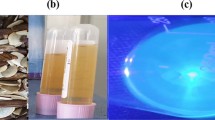Abstract
In this paper, the fluorescence enhancement phenomenon of carbon quantum dots (C-QDs) via metal fluorescence effect has been investigated. Firstly, uniform Ag nanoparticles was prepared, which theoretically can supply a strong enhancement effect with a diameter as small as 20 nm. Then SiO2 shell was utilized to control the distance between Ag core and C-QDs while surface charge of as-synthesized Ag@SiO2 was further modified to bond C-QDs via electrostatic effect. Four different kinds of SiO2 shell, with thickness 12 nm, 15 nm, 20 nm, and 27 nm, were synthesized to study the enhancement effect of distance. With the increase of SiO2 shell, the fluorescence of Ag@SiO2@NH2-C-QDs nanocomposites rise first but then fall while the sample with the 20-nm shell obtained the best enhancement effect as high as 3.92-fold. Surface charge vibration of metal particles was used to explain this phenomenon.








Similar content being viewed by others
References
Bhunia SK, Pradhan N, Jana NR (2014) Vitamin B1 derived blue and green fluorescent carbon nanoparticles for cell-imaging application. ACS Appl Mater Interfaces 6:7672–7679
Cheng H, Zhao Y, Fan Y, Xie X, Qu L, Shi G (2012) Graphene-quantum-dot assembled nanotubes: a new platform for efficient Raman enhancement. ACS Nano 6:2237–2244
Corrigan T, Guo S-H, Szmacinski H, Phaneuf R (2006) Systematic study of the size and spacing dependence of Ag nanoparticle enhanced fluorescence using electron-beam lithography. Appl Phys Lett 88:101112
Cui Q, He F, Wang X, Xia B, Li L (2012) Gold nanoflower@ gelatin core–shell nanoparticles loaded with conjugated polymer applied for cellular imaging. ACS Appl Mater Interfaces 5:213–219
Deng Y-L, Xu D-D, Pang D-W, Tang H-W (2017) Target-triggered signal turn-on detection of prostate specific antigen based on metal-enhanced fluorescence of Ag@ SiO2@ SiO2-RuBpy composite nanoparticles. Nanotechnology 28:065501
Falco W, Queiroz A, Fernandes J, Botero E, Falcão E, Guimarães F, M’Peko J-C, Oliveira S, Colbeck I, Caires A (2015) Interaction between chlorophyll and silver nanoparticles: a close analysis of chlorophyll fluorescence quenching. J Photochem Photobiol A 299:203–209
Gao X, Lu Y, Zhang R, He S, Ju J, Liu M, Li L, Chen W (2015) One-pot synthesis of carbon nanodots for fluorescence turn-on detection of Ag+ based on the Ag+-induced enhancement of fluorescence. J Mater Chem C 3:2302–2309
Guidelli E, Baffa O, Clarke D (2015) Enhanced UV emission from silver/ZnO and gold/ZnO core-shell nanoparticles: photoluminescence, radioluminescence, and optically stimulated luminescence. Sci Rep 5:14004
Hou J-W, Yang X-C, Cui M-M, Huang M, Wang Q-Y (2012) Synthesis of silver particles decorated anodic aluminium oxide substrates for metal-enhanced fluorescence. Micro Nano Lett 7:842–845
Kang KA, Wang J, Jasinski JB, Achilefu S (2011) Fluorescence manipulation by gold nanoparticles: from complete quenching to extensive enhancement. J Nanobiotechnol 9:16
Kowalska D, Krajnik B, Olejnik M, Twardowska M, Czechowski N, Hofmann E, Mackowski S (2013) Metal-enhanced fluorescence of chlorophylls in light-harvesting complexes coupled to silver nanowires. Sci World J:2013
Lakowicz JR (2001) Radiative decay engineering: biophysical and biomedical applications. Anal Biochem 298:1–24
Li X, Que L (2014) Fluorescence enhancement enabled by nanomaterials and nanostructured substrates: a brief review. Rev Nanosci Nanotechnol 3:161–176
Li C, Zhu Y, Zhang X, Yang X, Li C (2012) Metal-enhanced fluorescence of carbon dots adsorbed Ag@ SiO 2 core-shell nanoparticles. RSC Adv 2:1765–1768
Lim SY, Shen W, Gao Z (2015) Carbon quantum dots and their applications. Chem Soc Rev 44:362–381
Pang Y, Rong Z, Xiao R, Wang S (2015) “Turn on” and label-free core− shell Ag@ SiO 2 nanoparticles-based metal-enhanced fluorescent (MEF) aptasensor for Hg 2+. Sci Rep 5:9451
Peng Z, Han X, Li S, Al-Youbi AO, Bashammakh AS, El-Shahawi MS, Leblanc RM (2017) Carbon dots: biomacromolecule interaction, bioimaging and nanomedicine. Coord Chem Rev 343:256–277
Qian ZS, Shan XY, Chai LJ, Ma JJ, Chen JR, Feng H (2014) DNA nanosensor based on biocompatible graphene quantum dots and carbon nanotubes. Biosens Bioelectron 60:64–70
Saboktakin M, Ye X, Chettiar UK, Engheta N, Murray CB, Kagan CR (2013) Plasmonic enhancement of nanophosphor upconversion luminescence in Au nanohole arrays. ACS Nano 7:7186–7192
Schneider J, Reckmeier CJ, Xiong Y, von Seckendorff M, Susha AS, Kasák P, Rogach AL (2017) Molecular fluorescence in citric acid-based carbon dots. J Phys Chem C 121:2014–2022
Theodorou IG, Jawad ZA, Jiang Q, Aboagye EO, Porter AE, Ryan MP, Xie F (2017) Gold nanostar substrates for metal-enhanced fluorescence through the first and second near-infrared windows. Chem Mater 29:6916–6926
Wang Q, Zhang S, Ge H, Tian G, Cao N, Li Y (2015) A fluorescent turn-off/on method based on carbon dots as fluorescent probes for the sensitive determination of Pb2+ and pyrophosphate in an aqueous solution. Sensors Actuators B Chem 207:25–33
Xie F, Pang JS, Centeno A, Ryan MP, Riley DJ, Alford NM (2013) Nanoscale control of Ag nanostructures for plasmonic fluorescence enhancement of near-infrared dyes. Nano Res 6:496–510
Ye Z, Tang R, Wu H, Wang B, Tan M, Yuan J (2014) Preparation of europium complex-conjugated carbon dots for ratiometric fluorescence detection of copper (II) ions. New J Chem 38:5721–5726
Yuan H, Khatua S, Zijlstra P, Yorulmaz M, Orrit M (2013) Thousand-fold enhancement of single-molecule fluorescence near a single gold nanorod. Angew Chem Int Ed 52:1217–1221
Funding
This research was supported by the National Basic Research Program of China (973 program, Grant no. 2011CB013004) and Major Project of State Key Laboratory of Tribology (Grant no. SKLT2014A01).
Author information
Authors and Affiliations
Corresponding authors
Ethics declarations
Conflict of interest
The authors declare that they have no conflict of interest.
Additional information
Publisher’s note
Springer Nature remains neutral with regard to jurisdictional claims in published maps and institutional affiliations.
Electronic supplementary material
ESM 1
(DOCX 498 kb)
Rights and permissions
About this article
Cite this article
Wu, Q., Zhou, Z., Zhang, T. et al. Preparation of Ag@SiO2@NH2 core-shell nanocomposites for the fluorescence enhancement of carbon quantum dots. J Nanopart Res 21, 259 (2019). https://doi.org/10.1007/s11051-019-4676-1
Received:
Accepted:
Published:
DOI: https://doi.org/10.1007/s11051-019-4676-1




